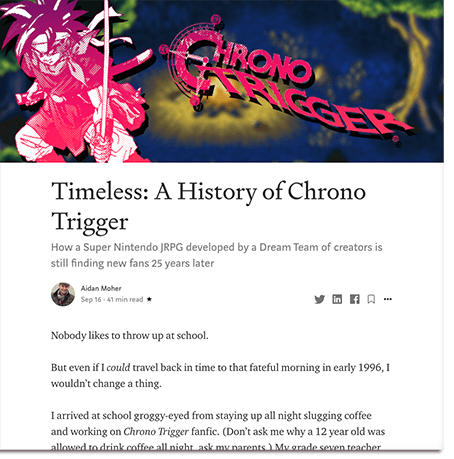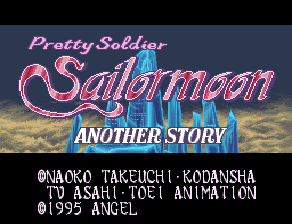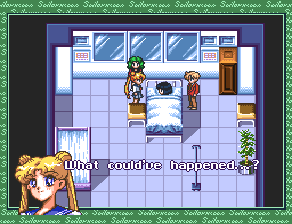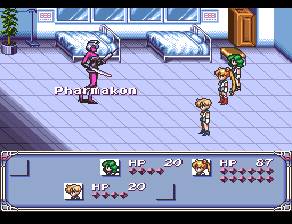Astrolabe 5: Fight, magic, items, Chrono Trigger, and another story

Announcing Fight, Magic, Items: A Personal History of Japanese RPGs*
*Title pending. Actually, everything pending.
I wrapped up Astrolabe #4 with a promise to write about world building in this issue, but I’m pushing that conversation to next issue because I’ve got some exciting news to share!
I’m working on a book! It’s tentatively called Fight, Magic, Items: A Personal History of Japanese RPGs. I announced it last week on Twitter:
The cat's outta the bag! My project w/ @ericsmithrocks is a history of #JRPGs. It's like this Chrono Trigger piece, but a book covering everything from Horii & Sakaguchi's early days, to FF7's meteoric rise, to the impact of modern JRPG-influenced games like @tobyfox's Undertale.
— Aidan Moher (@adribbleofink) 8:27 PM ∙ Sep 16, 2020
I’m working closely with my agent, Eric Smith of P.S. Literary, to polish up a pitch and 10K word sample that we’ll be querying soon. So, if y’all know an editor who looooooves Final Fantasy, maybe send ‘em Eric’s way?
Though we’re also working on my fiction books, Fight, Magic, Items is is actually the project that brought Eric and me together. We bonded over our mutual love for golden age Japanese RPGs, and the idea to take my games writing and turn it into a full-fledged book of reprints and new material seemed like a dream project for both of us.
Here’s how I pitched the book to Eric:
Fight, Magic, Items: A Personal History of Japanese RPGs reveals the history of Japanese RPGs from the time when Final Fantasy and Dragon Quest were little more than a scrappy level one adventurers with dreams of being the next Wizardry, to the halcyon days of Final Fantasy VII, to the modern era when a new generation of heroes is emerging, and the old ones—desperate to remain in the spotlight—are being remade for the new world.
This collection of new essays and select reprints of my work for sites such as Kotaku and EGM focuses on the humble beginnings and industry-dominating rise of Japanese RPGs. This history is couched in my own experience growing up in the 90s playing Final Fantasy and reading Tolkien. In the tradition of books like Chris Kohler's Final Fantasy V and Generation Decks by Titus Chalk, Fight, Magic Items combines researched and reported history with personal perspective, shedding light not only on the historic relevance of Japanese RPGs, but also the emotional journeys experienced by children of the 90s who now revisit old favourites as adults and introduce them to a new generation of gamers.
If you’re curious for a taste of what Fight, Magic, Items will offer, I have several pieces that explore different games with the voice and general approach I’ll be using in the book:
- Timeless: A History of Chrono Trigger (Insert Cartridge)
- Why Lunar: Silver Star Story Complete Remains One of the Best JRPGs Ever (EGM)
- Was Trials of Mana Worth Growing Up For? (Uncanny Magazine)
- Magic: The Gathering’s digital history, from first build to end step (GamesBeat)
- “Life… Dreams… Hope… Where do they come from?” A Final Fantasy VI Retrospective (Insert Cartridge)
Now's the time to equip your Prism Armour, and ardently but politely inundate your favourite publishers and booksellers with requests for jovial, well researched, anecdote-filled, and heartfelt personal histories of Japanese RPGs.
Out & About
(Out & About is where I highlight my work around the web—some recent and some old favourites.)

Relatedly, I released my enormous retrospective on the classic Super Nintendo Japanese RPG Chrono Trigger last week. Anyone who follows me on Twitter knows how important this game is to me—it’s one of my most prominent and consistent creative inspirations. “Timeless: A History of Chrono Trigger” is the story of Chrono Trigger’s origins, creation, impact, and legacy—and a profile of the designers, artists, programmers, and planners who made it all happen.
Like a combination of Secret of Mana and Final Fantasy VI, Chrono Trigger distilled everything that made the 16-bit console generation so beloved by its growing audience of JRPG fans, and so revered by gamers today. The genre would undergo a massive transformation after the release of Final Fantasy VII on the Sony PlayStation a couple of years later, marking Chrono Trigger as one of the last examples of console RPGs in the style popularized by the earlier Final Fantasy and Dragon Quest games. It truly was a melding of the generation’s best game mechanics, design philosophies, and creators.
This is a look back at 25 years of Chrono Trigger. The people who made it and played it. The memories. The ripples it left on time. It’s a celebration of one of gaming’s boldest and riskiest creative collaborations, and a reflection on how the unlikely coming together of A-list creators changed gaming forever.
I’ve wanted to write this one for about five years, and poured my heart and soul into it. Chrono Trigger is so dear to me, and its history is filled with fascinating details and a literal who’s who of Japanese RPG creators, that this one turned out really long. Whether you’re a fan of Japanese RPGs, a dabbler, or just like creative histories, there’s something in here for everyone. This is my magnum opus as a fan writer.
Read “Timeless: A History of Chrono Trigger” on Insert Cartridge
Some more:
- Pick a Pile: SNES Vs. PlayStation JRPGs (Insert Cartridge, May 2020)
- My Top 10 RPGs (Insert Cartridge, April 2020)
LTTP—Sailor Moon: Another Story (Super Nintendo, 1995)
( LTTP stands for “Late to the Party” and is a regular column where I let Twitter decide which retro game I’ll play for an hour. Do your worst, Twitter!)
This time around, instead of doing a poll, I had an open call for LTTP, and from the pile I chose Sandstone’s suggestion of Sailor Moon: Another Story. This Super Nintendo Japanese RPG has been on my radar ever since I was 13 years old and obsessed with the show, and a newly released fan translation seemed like the perfect opportunity to finally give it a try.

Right off the bat, I was impressed by how much the game’s graphics and art captured the show’s spirit. The big, vibrant character portraits, nice sprite work, and bright, welcoming environments are just plain fun, and I immediately felt like I was back home in my PJs watching Sailor Moon in the 90s. That particular anime aesthetic is really nostalgic for me, and playing this really brought me back to my childhood in a different way than most of the golden age Japanese RPGs I’ve been playing. It was fun experiencing that Sailor Moon nostalgia in a new way.
Matching the game’s colourful graphics is its soundtrack. Based on Takanori Arisawa’s for the anime, it’s bright and bubbly, but the short loops became quickly repetitive, especially whenever I’d get lost while exploring. Considering how much time you spend wandering around in Japanese RPGs, it’s so important to hit a loop that has enough variety that it doesn’t get immediately repetitive. Sailor Moon: Another Story doesn’t quite get there.

Which brings me to my major criticism of the game: the huge, empty, and repetitive environments. Not paying close attention to the dialogue because I was streaming probably didn’t help, but, as I pointed out during the stream, there are a lot of wide, open spaces in the game that are many times larger than they need to be. Making it worse, they offer no signposting for the critical path, or even unique details to differentiate themselves from similar surrounding environments. I aimlessly wandered the streets around Usagi’s home looking for the correct store to initiate the next plot beat, got lost in a high school that I thought was the hospital I was supposed to visit, and travelled down several identical streets on my way to fight some baddies. Put against its contemporaries, like Final Fantasy VI or Phantasy Star IV, which feature tightly designed and well-signposted maps, Sailor Moon: Another Story felt undisciplined and unnecessarily huge.
That being said, the environments themselves are fun and the set dressings really made it feel like you were part of the show. I love video games because they allow me to be an active participant in worlds that I can only enjoy passively while watching TV or movies. Getting to wander around the world of Sailor Moon was a treat, even if I spent most of my time getting lost.

What’s a JRPG without a great battle system? Sailor Moon: Another Story features combat that pulls over many elements from other games released around the same time. It’s got something similar to Chrono Trigger’s dual- and triple-techs, uses a turn-based system similar to Lufia 2: Rise of the Sinistrals, and features the snappy speed that’s a trademark of 16-bit JRPGS. Given the huge cast of characters (I had seven different party members during the first 45 minutes) and a wide variety of skills for each party member, it felt like there was a lot of room to grow over the course of the full game.
The version I played featured a new fan translation, and it really shows how far the fan translation community has evolved over the past two decades. While it made some choices that were unfamiliar to me as a fan of the 90s dub, the writing itself was immediately accessible and had all the charm, humour, and spunk I expect from the series.
You can watch my LTTP stream of Sailor Moon: Another Story on Twitch.
Sailor Moon: Another Story was released for the Super Nintendo in Japan in 1995. It never received an official North American release, though a great fan translation was released in 2019 by Bishoujo Senshi Translations, mteam, and vivify93.
Recommended Reads
Power-Up: How Japanese Video Games Gave the World an Extra Life by Chris Kohler—Since I’m working on a book about video games, it only makes sense to go back to read some of the best gaming histories available. Chris Kohler has been writing about retro gaming seemingly forever, and his intimate knowledge of the medium is on display in this classic volume. It’s packed with great stories and personal anecdotes—all told with Kohler’s unique, personable style.
Chrono Trigger by Michael P. Williams—This is the perfect companion piece to “Timeless: A History of Chrono Trigger.” As I did in my article, Williams takes a deep dive into Chrono Trigger’s history, revealing its fascinating creation with a clear voice, a ton of well-documented research, and a clear love for the game.
Quest Markers
(Quest Markers is a collection of the coolest stuff I’ve read around the web lately.)
- How Mass Effect’s FemShep Launched My Re-Entry Into Gaming (Insert Cartridge)
- Once a Bookseller, Always a Bookseller (Tor.com)
- Twitter: Charles Payseur on the narrow scope of “Best of…” anthologies
- The Video Games That Made People Question Their Beliefs (Kotaku)
- YouTube: Supermarket Instant Coffee - Which One Tastes Best? (James Hoffmann)
- How SNES emulators got a few pixels from complete perfection (Ars Technica)
End Step
I hope y’all are as excited for Fight, Magic, Items as I am! It’s a project that’s been a long time coming, and feels like the right project for me in 2020. I’ll be back soon with Astrolabe #6, when I’ll get to my promised look at world building, but before then, keep an eye out for the first Astrolabe Gaiden—a special side story issue of Astrolabe with some fun content for aspiring non-fiction writers.
Support
There are lots of ways to support Astrolabe and my other work. Check ‘em out!
- Patreon: http://patreon.com/adribbleofink
- Ko-fi: http://ko-fi.com/aidanmoher
- Paypal: http://paypal.me/AidanMoher
Keep In Touch
Enjoy Astrolabe? Want more SFF and retro gaming goodies? You can find me on Twitter and my website.
Credits
Astrolabe banner photo by Shot by Cerqueira on Unsplash

